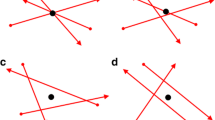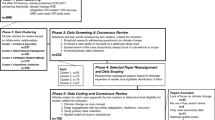Abstract
Maps are essential in climate change research and policymaking, and are primary tools for communicating climate change information to the public. The consequences of cartographic design are potentially significant to understanding climate change and effectively informing policymakers. Yet, the cartographic design and quality of climate change maps have not been critically assessed nor systematically evaluated. We suggest that evaluating the quality of climate change maps is both timely and essential, and offer one approach as a demonstration. We use cartographic design principles to evaluate a ‘high visibility’ climate change map from the 2007 report of the Intergovernmental Panel on Climate Change. Our specific goals are to demonstrate the need and value of cartographic critique, describe how such evaluation can be accomplished, and make a case for cartographers’ engagement with climate change scientists in mapping activities. We suggest a research and policy agenda for the cartographic evaluation and design of climate change maps.
Similar content being viewed by others
References
Arikawa M, Tsuruoka K, Fujita H, Ome A (2007) Place-tagged podcasts with synchronized maps on mobile media players. Cartogr Geogr Inf Sci 34(4):293–303
Bertin J (1981) Graphics and graphic information processing. Walter de Gruyter, Berlin (Translated by W. Bert and P. Scott)
Brewer CA (2005) Designing better maps: a guide for GIS users. ESRI, Redlands, CA
Butler D (2006) Mashups mix data into global service. Nature 439:6–7
Buttenfield BP (1996) Scientific visualization for environmental modeling: interactive and proactive graphics. In: Goodchild MF, Steyaert LT, Parks BO, Johnston C, Maidment D, Crane M, Glendinning S (eds) GIS and environmental modeling: progress and research issues. GIS World Books, Fort Collins, CO, pp 463–467
Buttenfield BP, Beard MK (1991) Visualizing the quality of spatial information. In: Technical papers 1991. Auto-Carto 10: proceedings of the 10th annual symposium on computer-assisted cartography. ACSM/ASPRS, Bethesda, MD, pp 423–427
Carter JR (2004) Cartography is alive (thank God!). Cartogr Perspect 49:4–9
Cassettari S (2007) More mapping, less cartography: tackling the challenge. Cartogr J 44(1):6–12
Dent B (1999) Cartography: thematic map design, 5th edn. WCB/McGraw-Hill, Boston, MA
Field K (2005) Editorial ‘maps still matter—don’t they?’. Cartogr J 42(2):81–82
Gartner G, Bennett DA, Morita K (2007) Towards ubiquitous cartography. Cartogr Geogr Inf Sci 34(4):247–257
IPCC (2007a) Climate change 2007: the physical science basis. In: Solomon S, Qin D, Manning M, Chen Z, Marquis M, Averyt KB, Tignor M, Miller HL (eds) Contribution of working group I to the fourth assessment report of the Intergovernmental Panel on Climate Change. Cambridge University Press, Cambridge, UK. Available at http://www.ipcc.ch/. Accessed 21 Nov 2007
IPCC (2007b) Summary for policymakers. In: Parry ML, Canziani OF, Palutikof JP, van der Linden PJ, Hanson CE (eds) Climate change 2007: impacts, adaptation and vulnerability. Contribution of working group II to the fourth assessment report of the Intergovernmental Panel on Climate Change. Cambridge University Press, Cambridge, UK, p 10. Available at http://www.ipcc.ch/. Figure 1 graphic available at http://www.ipcc.ch/graphics/gr-ar4-wg2.htm. Accessed 21 Nov 2007
IPCC (2007c) Climate change 2007: synthesis report. Summary for policymakers [unedited copy]. Available at http://www.ipcc.ch/. Accessed 21 Nov 2007
Kimerling AJ, Muehrcke PC, Muehrcke JO (2001) Map use: reading, analysis, and interpretation, 5th edn. JP, Madison, WI
Kintisch E, Kerr RA (2007) Breakthrough of the year: global warming, hotter than ever. Science 318(5858):1846–1847
Krygier J, Wood D (2005) Making maps: a visual guide to map design for GIS. Guilford, New York
Lilley RJ (2007) Who needs cartographers? Cartogr J 44(3):202–208
Lobben AK, Patton DK (2003) Design guidelines for digital atlases. Cartogr Perspect 44:51–62
MacEachren AM (1994) Some truth with maps: a primer on symbolization and design. Association of American Geographers, Washington, DC
McKendry JE (2000) The influence of map design on resource management decision making. Cartographica 37(2):13–25
Monmonier M (1993) Mapping it out: expository cartography for the humanities and social sciences. The University of Chicago Press, Chicago, IL
Monmonier M (1995) Drawing the line: tales of maps and cartocontroversy. Henry Holt and Company, New York
Monmonier M (1996) How to lie with maps, 2nd edn. The University of Chicago Press, Chicago, IL
Monmonier M (2006) Cartography: uncertainty, interventions, and dynamic display. Prog Hum Geogr 30(3):373–381
Monmonier M (2007) Cartography: the multidisciplinary pluralism of cartographic art, geospatial technology, and empirical scholarship. Prog Hum Geogr 31(3):371–379
Organización de Estados Iberoamericanos (2007) Cambio climático 2007: impactos, adaptación y vulnerabilidad. Available at http://www.oei.es/decada/presentacioneurop.htm. Accessed 4 Sept 2008
Petchenik BB (1983) A map maker’s perspective on map design research 1950–1980. In: Taylor DRF (ed) Graphic communication and design in contemporary cartography. Wiley, New York, pp 37–68
Plewe B (2007) Web cartography in the United States. Cartogr Geogr Inf Sci 34(2):133–136
Robinson AH, Morrison JL, Muehrcke PC, Kimerling AJ, Guptill SC (1995) Elements of cartography, 6th edn. Wiley, New York
Slocum T, McMaster RB, Kessler FC, Howard HH (2005) Thematic cartography and geographic visualization, 2nd edn. Pearson Education, Upper Saddle River, NJ
Struck D (2007) Emissions growth must end in 7 years, U.N. warns. Washington Post, 18 November, A10
Taylor DRF, Caquard S (2006) Cybercartography: maps and mapping in the information era. Cartographica 41(1):1–5
Tufte ER (1983) The visual display of quantitative information. Graphics, Cheshire, CT
Tufte ER (1990) Envisioning information. Graphics, Cheshire, CT
Tufte ER (1997) Visual explanations. Graphics, Cheshire, CT
Wood CH, Keller CP (1996) Design: its place in cartography. In: Wood CH, Keller CP (eds) Cartographic design: theoretical and practical perspectives. Wiley, Chichester, UK, pp 1–9
Author information
Authors and Affiliations
Corresponding author
Rights and permissions
About this article
Cite this article
McKendry, J.E., Machlis, G.E. Cartographic design and the quality of climate change maps. Climatic Change 95, 219–230 (2009). https://doi.org/10.1007/s10584-008-9519-5
Received:
Accepted:
Published:
Issue Date:
DOI: https://doi.org/10.1007/s10584-008-9519-5




